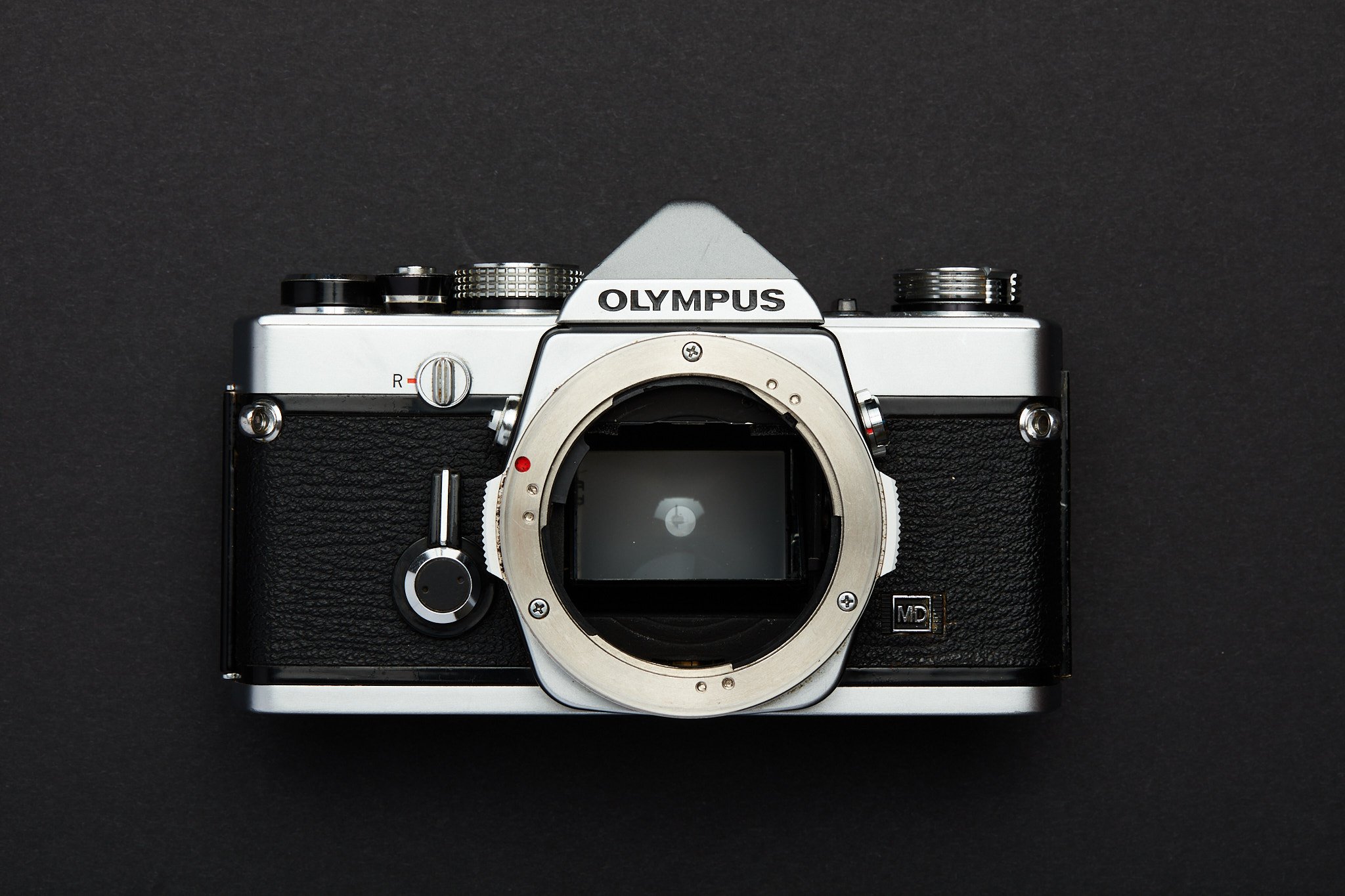Make it stand out
Whatever it is, the way you tell your story online can make all the difference.
The Infamous, Notorious, Fabulously Good OM-1n
Earlier in the year, as I surveyed my vast inventory of irrelevant 35mm film cameras, one called out to me.
“Use me, use me, I’ve been sitting here for years. You’ve never bothered to load a roll of film. Use me!”
As you might observe, the OM2S above is certainly not pristine. A previous owner used the crap out of it. That use was in no way abusive. The use was with care and love. It’s easy to see evidenced by the soft patina around the shutter button and the wear marks on the edges. This takes a lot of handling. If the camera pictured were an OM2, the OG that this model replaced, even a trace of black paint would be difficult to find. The top part of the camera would mostly be brass rather than the matte black finish. But wait, you say, that camera looks shiny, not matte. It sure does, that’s what happens before you eventually see the brass underneath.
Thanks for reading Camera Fashion! Subscribe for free to receive new posts and support my work.
Subscribed
The OM2S is a strange camera. It’s got a hodgepodge of features that don’t seem to make any sense looking at the OM professional line of cameras at the time of introduction. It has spot metering. It’s got manual, programmed, and aperture priority exposure control. The camera is obviously marketed as the next-gen OM2. How’s that strange? The answer lies in the camera lineup for 1984.
Decade out of date Fujifilm 400H pushed one stop, typical pink highlights.
The 1984 Olympus OM Lineup
The venerable OM1
The OM2S was the brand new model
The OM3 introduced the year before
The OM4 also a brand new model
So, in summary, we have the beloved manual exposure, center-weighted OM1 in that’s the same as it’s been since 1972 with a few minor upgrades and improvements along the way. Then there’s the very new OM3, a fully manual camera with a fancy multi-spot meter that operates in a lot of different modes. Apparently, that’s the OM1 “replacement”, which never happened. So much for that plan. The OM2 (a very popular camera in the OM line) is gone, done, outta here.
The two brand new fresh off the assembly line cameras in 1984 seem to both be candidates as the OM2 ”replacements”. The OM4 has aperture priority automation, fancy-schmancy multi-spot capability, and manual exposure. That fancy spot metering works in manual and aperture priority auto. The OM2S has spot metering but it only works in manual exposure. What’s more, is that manual mode is also how spot metering is turned on. Switch the lever to manual and spot metering it is, they are one and the same. Auto and programmed exposure are served by center-weighted metering, again controlled via the manual/program/auto lever on the top.
I don’t get it. We have OM1->OM3 upgrade path but the OG OM1 is still on sale. We have the OM2->OM4 upgrade path but instead of the OM2 we get a strange love child of the OM2 and kinda OM4 that’s called the OM2S? Was this an internal political battle within Olympus on how the replacement for the OM2 should work? So they decided to do both and let the best camera win? To force would be OM2 buyers to make the choice they eliminated the OM2 that same year? I like the mechanical manual only team’s plan a bit better. Here’s a new idea but if you like the old idea we still make that one as well.
The OM2S gives us the new style black finish, the only option now, no chrome. It’s more durable, it’s not painted but a coating of some sort. Leica started this a bit earlier. Not nearly as pretty as black paint when new and in my opinion doesn’t wear well from a purely aesthetic view. Mostly the coating just develops shiny spots that look more like greasy fingerprints on the matte finish. With rare exceptions as shown, it eventually will be mostly shiny spots and just a tiny bit of underlying metal. The point between new and what you see here is most of the camera’s lifetime; Not a great look.
Fujifilm 400H pushed one stop. Made with the OM2S on one of my evening walks.
The Incestuous Love Child Of The OM4 and OM2
Unfortunately, the OM2S inherited Daddy’s looks. Wonder in awe at the black chrome. No, don’t look at it just read the marketing verbiage as to better-ness. To distract us from its lack of beauty we’ve escalated the plastering of the model and feature set on the front of the camera as large as possible. Don’t worry folks, that gets worse as time goes on. Even Nikon succumbed to this with the FM2 and FE2. We get the more squared-off prism but unlike the symmetrical light pipe on Daddy, we get an odd placement above the marketing billboard. We’re also treated to the ugly electro-mechanical big round self-timer that’s extra gaudy in use.
Mom’s DNA gave us few positives. Best of all we get simple operation and no button clutter. One lever that sets the camera operation and the most appropriate meter mode that comes along for the ride. It doesn’t get any simpler than this. Manual means I know what I am doing and want to set the camera a certain way taking what I meter into account. Bingo, manual mode with spot metering, done. Nothing complicated here, I just want to set the aperture and let the camera figure out the shutter speed. Again one flip of the lever and done, shoot away. Don’t worry the camera will warn you in the finder and beep if no shutter speed will work. Then there’s the “I’ve been partying, I don’t know aperture from a toilet” mode. Flip the lever and we’ve got programmed mode.
What I am sure the marketing department wanted you to think is that the OM2S was inferior to the mighty OM4. They did a good job in cahoots with the engineers. I don’t blame the engineers, they’re naive. The engineers thought they were giving their blood, sweat, and tears for the greatest invention and feature set since the bread that comes sliced.
Hell, with no marketing guys in sight just reading the OM4 manual will convince you that the OM4’s variable spot that works in automatic is everything you’ve ever wanted in a camera. The holy grail of exposure systems. It’s fast and deadly accurate no matter what shooting conditions you may be facing. I even thought it was a great idea. I still do... intellectually.
Then the real world happens and nothing beats simple. If you use an OM4 what happens is you either end up using it a lot like an OM2S. Selecting this manner of real-world operation makes you a member of the screw-it faction. Others might doggedly insist on using all the features as designed only to be slower, more error-prone, and never realizing the beauty of simplicity. These people are the but-it-should-work-better faction. Eventually, they delude themselves into it-is-better Lala-land. It’s not.
The OM4 is a great camera, the OM2 is the same camera in real-world use. Well, it’s the same camera but has way more buttons crowded around the shutter release. And then again theirs the extra step of activating and clearing the spot meter in some situations. Or... there’s the crap the spot meter cleared itself issue when you take that next shot in auto. Without further beatings of the horse, the OM2 suffers a mild case of what all modern cameras suffer. Lots of features and buttons that do everything, at any time, given any circumstance or subject. The OM4 is a very early step in the all things to all people all the time school of camera design.
You can tell me, I’ll keep it a secret, you know you only use the same focus mode and either aperture priority or manual. Of course, you do. I don’t know anyone that uses the 27 ways to expose, 44 ways to focus, or any of the other junk on their cameras. Even the customize the 22 buttons and dials guys don’t ever actually use those buttons to change stuff. When they do, they forget how they set it up.
What appears to be some sort of product planning mistake happens to be a very practical and useful iteration within the OM professional camera line. Olympus only made the OM2S for four years, which makes it the shortest manufacturing run of any of the OM pro cameras. The OM2S stopped being made in 1988. The OM4 soldiered on and continues to be a popular and highly regarded camera. A great camera but it’s a mistake to think an OM2S isn’t just as good in real-world use.
I’ll close this out with the thing everyone likes to talk about; Battery sudden death syndrome. The talk goes something like this... The OM2S eats batteries and if you look at it funny it will, unexpectedly, without explanation, die. The truth of it is that the “auto-off” meter operation doesn’t seem to turn everything all the way off, as in hard-switch disconnected. If you are used to cameras like the OM1 where the meter battery will last for years, the OM2S will last for months.
The other issue is the warning beeper and the meter backlight. These two things seem to be huge power sucks along with the “battery check”. Don’t use them and avoid constantly turning the meter on via shutter press with the over-exposure beeping constantly. The battery life is fine given the provisions outlined. Carry two with you, problem solved. You will never ever, never ever, never ever, use a fresh pair up in a week let alone a day. If you leave fresh batteries in there for two years, hmmmmm, that’s another story. Replace them and move on.


